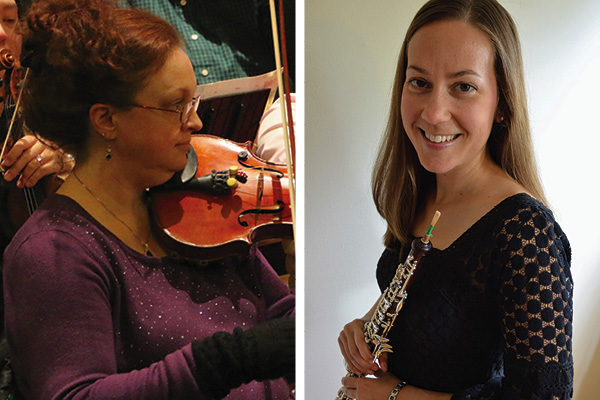November 20, 2021 Looking Bach-wards

PROGRAM NOTES
Edvard Hagerup Grieg
(Born in Bergen, Norway in 1843; died in Bergen in 1907)
Holberg Suite (Fra Holbergs tid), Op. 40
Praeludium. Allegro vivace
Sarabande. Andante
Gavotte. Allegretto –– Musette. Un poco mosso
Air. Andante religioso
Rigaudon. Allegro con brio
The marvelous works of Norwegian composer Edvard Grieg seem to capture an ineffable sweetness and nostalgia as few other composers’ could. Grieg’s music somehow always satisfies the soul, and so it is with one of his most popular works, his Holberg Suite, written in 1884.
The suite’s inspiration and honoree, Baron Ludwig Holberg (1684–1754), was born in Bergen in 1684, but spent much of his life in Denmark following a tragic fire in his Norwegian hometown. Besides being known as a remarkable historian and scientist, Holberg also had a great talent for writing satires and comedies, so much so that he became known as “the Molière of the North.” Two hundred years after his birth, in 1884, both Norway and Denmark held bicentennial celebrations for their famous, shared native son. Several composers were commissioned to write grand cantatas for these occasions, and Grieg obliged with his Holberg Cantata. That work was swiftly forgotten, but happily for us Grieg also created a delightful piano suite that has endured: Fra Holbergs tid (“From Holberg’s time”), Op. 40. Grieg soon orchestrated and revised the piano suite for strings; this is the version most often heard today and the one performed tonight.
Grieg nicknamed his Holberg Suite his “powdered-wig piece,” and he crafted it with a surprising twist. Realizing that Holberg was a contemporary of the Baroque-era musical giants Bach, Handel and Scarlatti (all born in 1685; Holberg was born just one year prior), Grieg fashioned his homage as a Baroque dance suite to echo the music that Holberg would have heard in his era. Although Holberg and his contemporaries would have recognized Grieg’s collection of dances, Grieg’s particularly gorgeous Romantic melodies and harmonies would have been something of a shock in the early 1700s.
To our modern ears, Grieg’s Holberg Suite is not shocking at all but is instead one of his most beloved works. Beginning with the bracing Praeludium, which is like a horse race with its driving rhythms, Grieg uses the Baroque dance forms only as a launching point for his Romantic-era music-making. The Sarabande is almost Mahler-esque in its beauty and is followed by the Gavotte/Musette that gives pride of place to Grieg’s Norwegian folksong and dance. The Air is one of Grieg’s loveliest themes: its simplicity fittingly echoes the exquisite slow movements of Scarlatti and Bach, but it is infused with a beautiful Romantic melancholy. At the finale, Grieg again chooses a form, the rigaudon, that showcases his love of Norwegian dance. With a weighty and slow middle section that evokes the feeling of a soft love song, the movement is otherwise surrounded by a rustic round dance with virtual foot stomping, fancy fiddling and collective merriment.
Johann Sebastian Bach
(Born in Eisenach, Germany in 1685; died in Leipzig, Germany in 1750)
Concerto for violin and oboe in D minor, BMV 1060
1. Allegro
2. Adagio
3. Allegro
It may seem inconceivable to us that many of Bach’s compositions, including this concerto, hovered on the brink of extinction. But the truth is that many works by many composers have been lost to the ages. Indeed, we may never have known of many of Bach’s early melody-instrument concertos from his days as kapellmeister for Prince Leopold of Cöthen (1717–1723) if he had not reused these works later on. In the case of the concerto for violin and oboe featured in tonight’s concert, all that remains is Bach’s transcription of it as a concerto for two harpsichords and strings from almost a decade later, and that transcription itself only survives in a manuscript copied by his students after his death. Eventually, several hundred years later, this manuscript was used as the basis for a “reverse transcription” to the presumed original for violin and oboe. Thus, it can fairly be said that although many compositions have come and gone and been lost or forgotten, true masterpieces usually find a way of weathering the ages. This concerto is one of those.
The concerto form as used by Bach grew out of the Baroque Italian “concerto grosso” that was perfected by Vivaldi (of The Four Seasons). Though Bach did not invent any new forms, he certainly set new melodic and harmonic standards for existing ones. Tonight’s concerto is a wonderful example. As in most of these concerti, the outer movements are in ritornello form, where the opening statement (the ritornello) returns in various keys and guises throughout the movement. (This is similar to the later rondo form, or ABACAB, and so on; the ritornello being, as it were, section A). In the first movement, the ritornello is heard in its full form only at the beginning and end, as its echo-like last bars lend themselves to many musical manipulations.
The gem of this concerto, however, may well be the second movement, which is as lyrical and lovely as any music Bach wrote. Its gentle, rocking feel and movingly expressive interplay between the oboe and violin achieve a sublime tenderness that is rarely matched by composers of any era. In the spectacular last movement the ritornello gives us the impression that a mighty Bachian fugue is about to unfold. Instead, through Bach’s ingenious contrapuntal abilities, the work launches into a host of enchanting derivations, and portions of the ritornello pervade nearly every phrase. Whereas the second movement allowed the oboe to unfold its singing charms, the finale gives the violin much of the virtuoso’s spotlight.
Pyotr Ilyich Tchaikovsky
(Born in Kamsko-Votkinsk, near Kirov, Russia in 1840; died in St. Petersburg, Russia, in 1893)
Souvenir de Florence (string sextet, arr. for string orchestra), Op. 70
1. Allegro con spirito
2. Adagio cantabile e con moto
3. Allegretto moderato
4. Allegro con brio e vivace
Tchaikovsky wrote his brilliant Souvenir de Florence in 1890, just after he returned to St. Petersburg from an intense composing “vacation” in his favorite Italian city, Florence. While in Florence, he composed Pique Dame (“Queen of Spades”), an opera based on a Russian novel. Arriving back home in Russia, he immediately threw himself into a new project: a composition written especially for the St. Petersburg Chamber Music Society, as thanks for the society having made him an honorary member. In just under a month, this work was complete; after a few revisions, Souvenir de Florence had its public premiere in 1892.
Just as Tchaikovsky had often brought Russian themes to Italy, in Souvenir he likewise brought some of his beloved Florence back home to St. Petersburg. In fact, one of the themes of his new composition was written while in Florence — a “souvenir” of sorts from that place. But that’s not all. Just before Tchaikovsky and the rest of the great 19th-century Russian composers came on the scene, Russia had imported its classical music mainly from Italy and was boastful of hosting some of the greatest Italian composers and musicians. In Souvenir de Florence, Tchaikovsky amalgamates all of this — Italianesque lyricism, Russian folksong, and high-level counterpoint — to create a masterpiece. All in all, the work is a marvel of creativity and cosmopolitanism, in which Tchaikovsky flexes his late-career compositional muscles.
Souvenir was written as a string sextet scored for two violins, two violas and two cellos, and it is one of Tchaikovsky’s finest chamber compositions. While he was working on it, however, he wrote to a friend, “I constantly feel as though … I am in fact writing for the orchestra and just rearranging it for six string instruments.” Tonight, and fittingly, the sextet is performed as later arranged for string orchestra. Immediately, one notices that Tchaikovsky had big, multilayered soundscapes in mind.
The first movement is full of verve and bravura, with a contrasting middle theme of light and warmth for balance. The opening theme delivers some exceptional interplay between the instruments—it is chamber-like in its virtuosic treatment and even more exciting with multiple strings. And then Tchaikovsky turns up the mania as the movement gains more and more momentum toward its electrifying ending.
In the second movement, Adagio, Tchaikovsky uses his Florentine “souvenir” theme, a meltingly lyrical love duet between violins and cellos. Listen for the cello’s first, brief entrance before it takes up the main theme: This is a moment of sheer beauty, like a distant shooting star. Altogether, whether the love happened in Italy or Russia, this movement reminds us of how Tchaikovsky came to master the waltz in opera, ballet, and symphony, creating dance movements of exquisite grace and delicacy.
The Allegretto shifts radically in tone, sounding deeply Russian and folksy, and delightfully tuneful. Coupled with a middle section of quicksilver dancing strings as light as spider webs, which soon become cleverly mingled with that opening Russian folk tune, the Allegretto is a creation of a truly cosmopolitan composer at the top of his compositional and creative craft.
The last movement, Allegro con brio, also gives a strong Russian feel, like a gopak (a vigorous Russian country dance), suitable for stomping feet. But soon enough it bedazzles with contrapuntal magic, starting a fugato (like a fugue), and then brilliantly overlaying the very first theme from the first movement. It’s a grand mix of sunny Italy and rustic, vibrant Russia. The entire movement, in degrees, cartwheels into faster and faster moments, including a wondrously reckless full fugue (of which Tchaikovsky was expressly proud), until the ending, where the work concludes with a breakneck, spine-tingling finale.
© Max Derrickson



